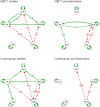The Impact of Treatments for Depression on the Dynamic Network Structure of Mental States: Two Randomized Controlled Trials
- PMID: 28425449
- PMCID: PMC5397847
- DOI: 10.1038/srep46523
The Impact of Treatments for Depression on the Dynamic Network Structure of Mental States: Two Randomized Controlled Trials
Abstract
Evidence is growing that vulnerability to depression may be characterized by strong negative feedback loops between mental states. It is unknown whether such dynamics between mental states can be altered by treatment. This study examined whether treatment with imipramine or treatment with Mindfulness-Based Cognitive Therapy (MBCT) reduces the connectivity within dynamic networks of mental states in individuals with depressive symptoms. In the Imipramine trial, individuals diagnosed with major depression were randomized to imipramine treatment or placebo-pill treatment (n = 50). In the Mind-Maastricht trial, individuals with residual depressive symptoms were randomized to Mindfulness-Based Cognitive Therapy (MBCT) or to a waiting-list control condition (n = 119). Lagged associations among mental states, as assessed with the Experience Sampling Method (ESM), were estimated at baseline and post-intervention. The results show that few of the dynamic network connections changed significantly over time and few of the changes after MBCT and imipramine treatment differed significantly from the control groups. The decrease in average node connectivity after MBCT did not differ from the decrease observed in the waiting-list control group. Our findings suggest that imipramine treatment and MBCT do not greatly change the dynamic network structure of mental states, even though they do reduce depressive symptomatology.
Conflict of interest statement
The authors declare no competing financial interests.
Figures




Similar articles
-
The efficacy of mindfulness-based cognitive therapy as a public mental health intervention for adults with mild to moderate depressive symptomatology: a randomized controlled trial.PLoS One. 2014 Oct 15;9(10):e109789. doi: 10.1371/journal.pone.0109789. eCollection 2014. PLoS One. 2014. PMID: 25333885 Free PMC article. Clinical Trial.
-
Relapse/Recurrence Prevention in Major Depressive Disorder: 26-Month Follow-Up of Mindfulness-Based Cognitive Therapy Versus an Active Control.Behav Ther. 2018 Sep;49(5):836-849. doi: 10.1016/j.beth.2018.02.001. Epub 2018 Feb 8. Behav Ther. 2018. PMID: 30146148 Free PMC article. Clinical Trial.
-
Added value of Mindfulness-Based Cognitive Therapy for Depression: A Tree-based Qualitative Interaction Analysis.Behav Res Ther. 2019 Nov;122:103467. doi: 10.1016/j.brat.2019.103467. Epub 2019 Sep 6. Behav Res Ther. 2019. PMID: 31557693
-
Mindfulness-based cognitive therapy for bipolar disorder: A systematic review and meta-analysis.Psychiatry Res. 2020 Aug;290:113116. doi: 10.1016/j.psychres.2020.113116. Epub 2020 May 25. Psychiatry Res. 2020. PMID: 32480120
-
Mindfulness and bodily distress.Dan Med J. 2012 Nov;59(11):B4547. Dan Med J. 2012. PMID: 23171754 Review.
Cited by
-
Relating stability of individual dynamical networks to change in psychopathology.PLoS One. 2023 Nov 9;18(11):e0293200. doi: 10.1371/journal.pone.0293200. eCollection 2023. PLoS One. 2023. PMID: 37943819 Free PMC article.
-
Investigating differential effects of socio-emotional and mindfulness-based online interventions on mental health, resilience and social capacities during the COVID-19 pandemic: The study protocol.PLoS One. 2021 Nov 4;16(11):e0256323. doi: 10.1371/journal.pone.0256323. eCollection 2021. PLoS One. 2021. PMID: 34735441 Free PMC article. Clinical Trial.
-
The Network Structure of Tobacco Withdrawal in a Community Sample of Smokers Treated With Nicotine Patch and Behavioral Counseling.Nicotine Tob Res. 2020 Mar 16;22(3):408-414. doi: 10.1093/ntr/nty250. Nicotine Tob Res. 2020. PMID: 30452739 Free PMC article. Clinical Trial.
-
Modelling suicide ideation from beep to beep: Application of network analysis to ecological momentary assessment data.Internet Interv. 2019 Nov 20;18:100292. doi: 10.1016/j.invent.2019.100292. eCollection 2019 Dec. Internet Interv. 2019. PMID: 31828015 Free PMC article.
-
A complex systems approach to the study of change in psychotherapy.BMC Med. 2020 Jul 14;18(1):197. doi: 10.1186/s12916-020-01662-2. BMC Med. 2020. PMID: 32660557 Free PMC article.
References
-
- Kendler K. S., Zachar P. & Craver C. What kinds of things are psychiatric disorders? Psychol. Med. 41, 1143–1150 (2011). - PubMed
-
- Cramer A. O. J., Waldorp L. J., van der Maas H. L. J. & Borsboom D. Comorbidity: A network perspective. Behav. Brain Sci. 33, 137–150 (2010). - PubMed
-
- Wichers M. The dynamic nature of depression: a new micro-level perspective of mental disorder that meets current challenges. Psychol. Med. 44, 1349–1360 (2014). - PubMed
Publication types
MeSH terms
Substances
LinkOut - more resources
Full Text Sources
Other Literature Sources
Molecular Biology Databases

